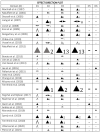Computer-based assessment of unilateral spatial neglect: A systematic review
- PMID: 36061603
- PMCID: PMC9437703
- DOI: 10.3389/fnins.2022.912626
Computer-based assessment of unilateral spatial neglect: A systematic review
Abstract
Background: To date, no gold standard exists for the assessment of unilateral spatial neglect (USN), a common post-stroke cognitive impairment, with limited sensitivity provided by currently used clinical assessments. Extensive research has shown that computer-based (CB) assessment can be more sensitive, but these have not been adopted by stroke services yet.
Objective: We conducted a systematic review providing an overview of existing CB tests for USN to identify knowledge gaps and positive/negative aspects of different methods. This review also investigated the benefits and barriers of introducing CB assessment tasks to clinical settings and explored practical implications for optimizing future designs.
Methodology: We included studies that investigated the efficacy of CB neglect assessment tasks compared to conventional methods in detecting USN for adults with brain damage. Study identification was conducted through electronic database searches (e.g., Scopus), using keywords and standardized terms combinations, without date limitation (last search: 08/06/2022). Literature review and study selection were based on prespecified inclusion criteria. The quality of studies was assessed with the quality assessment of diagnostic accuracy studies tool (Quadas-2). Data synthesis included a narrative synthesis, a table summarizing the evidence, and vote counting analysis based on a direction of effect plot.
Results: A total of 28 studies met the eligibility criteria and were included in the review. According to our results, 13/28 studies explored CB versions of conventional tasks, 11/28 involved visual search tasks, and 5/28 other types of tasks. The vote counting analysis revealed that 17/28 studies found CB tasks had either equal or higher sensitivity than conventional methods and positive correlation with conventional methods (15/28 studies). Finally, 20/28 studies showed CB tasks effectively detected patients with USN within different patient groups and control groups (17/28).
Conclusions: The findings of this review provide practical implications for the implementation of CB assessment in the future, offering important information to enhance a variety of methodological issues. The study adds to our understanding of using CB tasks for USN assessment, exploring their efficacy and benefits compared to conventional methods, and considers their adoption in clinical environments.
Keywords: attention; computer-based assessment; stroke; systematic review; unilateral spatial neglect (USN); visual search.
Copyright © 2022 Giannakou, Lin and Punt.
Conflict of interest statement
The authors declare that the research was conducted in the absence of any commercial or financial relationships that could be construed as a potential conflict of interest.
Figures
Similar articles
-
Virtual Reality and Eye-Tracking Assessment, and Treatment of Unilateral Spatial Neglect: Systematic Review and Future Prospects.Front Psychol. 2022 Mar 22;13:787382. doi: 10.3389/fpsyg.2022.787382. eCollection 2022. Front Psychol. 2022. PMID: 35391965 Free PMC article.
-
Spatial and temporal dynamics of visual search tasks distinguish subtypes of unilateral spatial neglect: Comparison of two cases with viewer-centered and stimulus-centered neglect.Neuropsychol Rehabil. 2016 Aug;26(4):610-34. doi: 10.1080/09602011.2015.1051547. Epub 2015 Jun 10. Neuropsychol Rehabil. 2016. PMID: 26059555
-
Pediatric unilateral spatial neglect: A systematic review.J Pediatr Rehabil Med. 2021;14(3):345-359. doi: 10.3233/PRM-200779. J Pediatr Rehabil Med. 2021. PMID: 34459422 Free PMC article.
-
Treatment of unilateral spatial neglect after stroke using transcranial direct current stimulation (ELETRON trial): study protocol for a randomized controlled trial.Trials. 2016 Oct 3;17(1):479. doi: 10.1186/s13063-016-1598-4. Trials. 2016. PMID: 27716442 Free PMC article. Clinical Trial.
-
The future of Cochrane Neonatal.Early Hum Dev. 2020 Nov;150:105191. doi: 10.1016/j.earlhumdev.2020.105191. Epub 2020 Sep 12. Early Hum Dev. 2020. PMID: 33036834
Cited by
-
European Stroke Organisation (ESO) guideline on visual impairment in stroke.Eur Stroke J. 2025 May 22:23969873251314693. doi: 10.1177/23969873251314693. Online ahead of print. Eur Stroke J. 2025. PMID: 40401755 Free PMC article.
-
Advancements in brain-computer interfaces for the rehabilitation of unilateral spatial neglect: a concise review.Front Neurosci. 2024 May 9;18:1373377. doi: 10.3389/fnins.2024.1373377. eCollection 2024. Front Neurosci. 2024. PMID: 38784094 Free PMC article. Review.
-
Impact of Virtual Reality Cognitive and Motor Exercises on Brain Health.Int J Environ Res Public Health. 2023 Feb 25;20(5):4150. doi: 10.3390/ijerph20054150. Int J Environ Res Public Health. 2023. PMID: 36901160 Free PMC article. Review.
-
Virtual reality tasks with eye tracking for mild spatial neglect assessment: a pilot study with acute stroke patients.Front Psychol. 2024 Jan 29;15:1319944. doi: 10.3389/fpsyg.2024.1319944. eCollection 2024. Front Psychol. 2024. PMID: 38348259 Free PMC article.
References
-
- Azouvi P. (1996). Functional consequences and awareness of unilateral neglect: study of an evaluation scale. Neuropsychol. Rehabil. 6, 133–150. 10.1080/713755501 - DOI
Publication types
LinkOut - more resources
Full Text Sources
Miscellaneous



